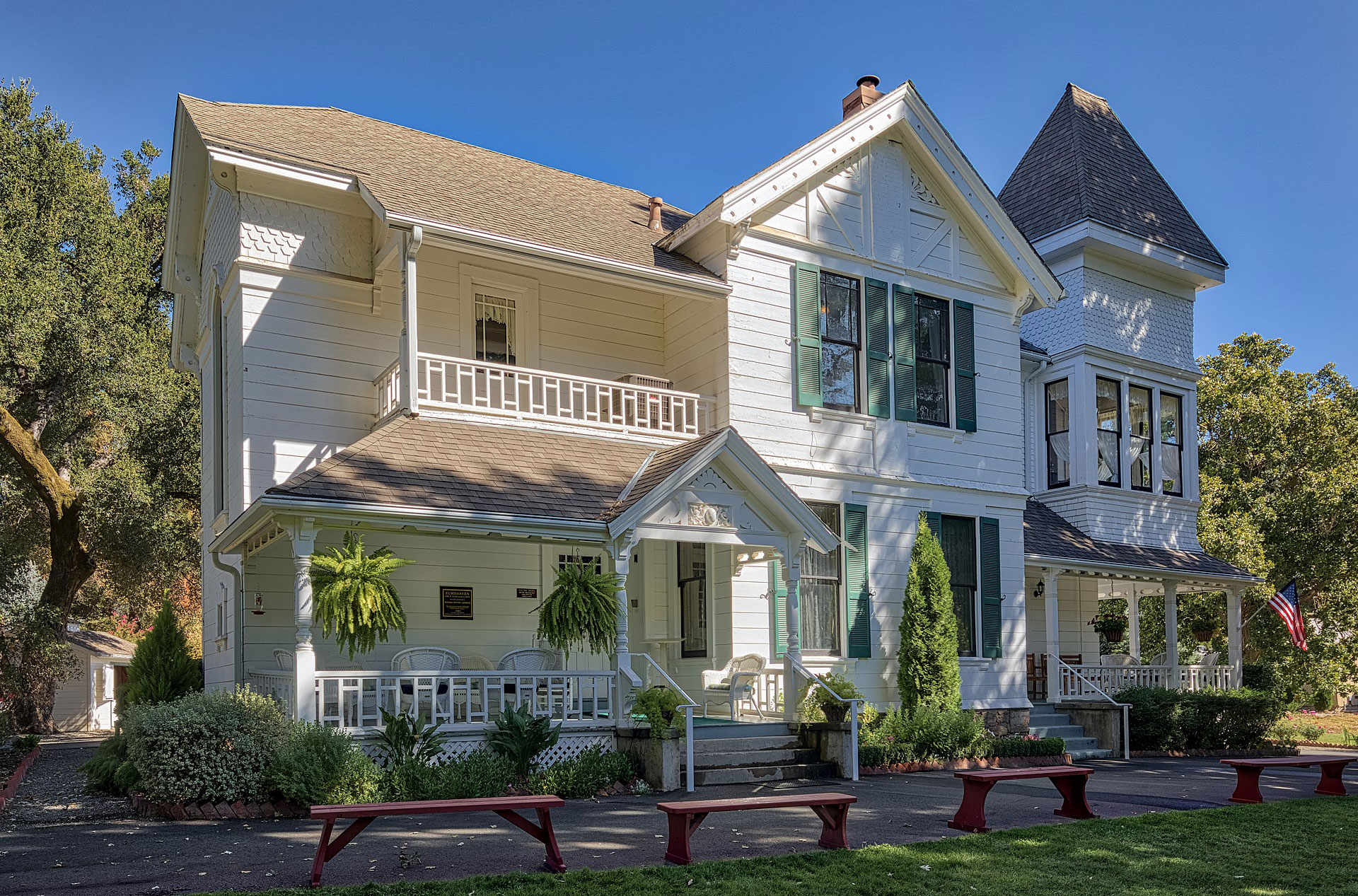This stately country Victorian residence — known since 1900 as Elmshaven — was built in 1885 by railroad developer and executive Robert H. Pratt and served as a vacation home to the Pratt family until 1900. Ellen G. White, one of the founders of the Seventh-day Adventist Church, purchased the home in 1900 and lived here until her death in 1915.
Today, the home is furnished much as it was when Ellen White lived and worked here. In fact, many of the furnishings belonged to her, and still sit where she placed them. Elmshaven is owned and maintained by the Seventh-day Adventist Church, but is open to the public. Whether you are interested in architecture, antiques, church history, or just want to see how some people lived 100 years ago, you are welcome to enjoy the peaceful environment of Elmshaven.
Location
History
From: https://www.discoverelmshaven.org/experiences
Robert Pratt
In the gold-rush days of 1849 and 1850, three Pratt brothers, Robert, George and William, of Freeport, Maine, traveled by sailing ship to San Francisco, each seeking a fortune. Only modestly successful in mining, the men, all in their twenties, turned to raising stock, farming, and building. In so doing they accumulated considerable property in northern California.
In 1871, William purchased valley land in Napa county, north of Glass Mountain — an abandoned Indian stronghold — and subsequently divided it with his brother Robert. Robert’s half included the Elmshaven property. Each brother shared a half interest in the remarkably reliable Crystal Spring on the side of Howell Mountain. George became a successful vineyardist in St. Helena. William continued farming and joined the Seventh-day Adventist church in 1873. In 1877, he helped establish a medical institution known as The Rural Health Retreat, contributing ten acres of his hillside land, his half interest in Crystal Spring, and financial backing. The Health Retreat was later renamed St. Helena Hospital and Health Center, which still delivers medical care within walking distance of Elmshaven.
Robert Pratt turned to railroad interests and was involved in constructing the rail lines across the Sierras. Later he filled the position of Assistant General Superintendent of the Southern Pacific Railroad. It was while thus engaged that he constructed as his home the well-built residence now known as Elmshaven.
In early 1900, with children grown and gone, the “Robert Pratt Place”, as it was known, with its 74 acres and half interest in Crystal Spring, was put up for sale. The Rural Health Retreat manager, John A. Burden, hard pressed for an adequate water supply for the institution and needing valley land for sewage disposal and for a site for a health food factory, quickly arranged for the Health Retreat to purchase the property. At the time, he did not know what he would do with the residence and the remaining portion of the farm. This problem was soon solved, however, with the arrival of Ellen White and her company in the fall of that year.
Ellen White, Pioneer
Ellen White and her publisher-husband, James White, both founding leaders in the Seventh-day Adventist Church, first visited California in 1872. Within the next two years James inaugurated a widely known weekly religious journal, Signs of the Times, still published as a monthly magazine. He also established Pacific Press, a publishing house in Oakland. For many years it was the largest and best-equipped publishing house west of the Rocky Mountains. Today the Pacific Press, with its greatly enlarged plant, is headquartered in Nampa, Idaho.
Shortly after the death of her husband in 1881, Ellen White, with her son, William, was instrumental in starting and nurturing a liberal arts college at Healdsburg, California, now in operation at Angwin as Pacific Union College.
She also provided inspiration and support for Loma Linda University, in Southern California, with its famous medical center and schools of medicine, dentistry, nursing, public health, pharmacy, etc. She was deeply involved in founding and maintaining a chain of medical institutions across North America, with the St. Helena Hospital and Health Center among the first. Others include Glendale Adventist Medical Center (near Los Angeles), Paradise Valley Hospital (San Diego), and Loma Linda University Medical Center. A large hospital in Los Angeles is named in her honor; the White Memorial Medical Center.
Ellen White is widely known for the 60 religious books she wrote; some published in dozens of languages. Many of these enjoy annual sales greater than average books enjoys in a lifetime — and this decades after her death in 1915. Combined yearly sales run into millions of copies.
Ellen White at Elmshaven
At Elmshaven in her sunset years, Ellen White brought out nine substantial volumes, all in current distribution, and prepared for publication hundreds of articles for the journals of the church.
Leaving Australia, where she had labored for nine years, Ellen White, her son, William, and his family, and her editorial assistants, arrived in San Francisco in September 1900. She had no clear idea where she would make her home, but in her heart was the assurance that there was a “haven” for her, somewhere. She was 72 years of age, with several future books in mind, and she favored being close to the Pacific Press, then in Oakland.
After several days of frustrating house hunting, she was persuaded to go to the Rural Health Retreat in St. Helena to rest and visit with old acquaintances. She shared her house hunting perplexity with one friend, a Mrs. Ings, who told her that the Robert Pratt home was available. Hastening to visit it, Ellen White found the seven-room home on a knoll near the middle of the property (reduced by that time to 60 acres). The land stretched from rich river-bottom land on the west to the mountains on the east and well up the steep hillside. The land, the completely furnished residence and the farm buildings were available for $5,000.
Ellen White credited God with providing a property so well adapted to her needs, and she quickly signed papers giving her immediate possession. With her staff, she moved in on October 16, just 25 days after docking in San Francisco.
“This is a most beautiful location,” she wrote to a friend. “The surroundings are lovely.” She described ornamental trees from various parts of the world, flowers, shrubs, extensive orchards, etc. Behind the house to the east was “the farmer’s cottage,” which, with a little adaptation, could be turned into an office building. Beyond this was a barn and stable, completely stocked with livestock and equipment. Several springs at the foot of Howell Mountain would supply water. There were also several good building sites that could be used for homes for her staff.
Overjoyed, Ellen White wrote to friends: “It is like stepping out of our [”Sunnyside”] home in Cooranbong [Australia] into one already prepared for use, without any care on our part.” Letter 146, 1900.
The property had been known as the “Robert Pratt Place,” but Ellen White needed a new name to put at the top of the thousands of letters and documents that would flow from this new home and office. Someone proposed “Shady Elms,” for there was a row of elm trees in front of the house. “Elmshaven” appeared in the heading of a letter written a few days later, and “Elmshaven” it has remained.
Development
Ellen White gave or sold building sites to her son, William, and to others of her helpers. But there was still ample land left for orchards, vineyards, gardens, berry patches, hay fields, and cow pasture. There were 2,000 prune trees in the orchards when she bought the place. The vineyard of wine grapes was soon replaced with table grapes.
An eight-room, two-story office building was erected in 1903, north of the house. In 1907, a library room and manuscript vault were added. A “dipping shed,” for processing prunes, was erected near the orchards. To supplement the spring water, a well was dug near the dipping shed and a four-story tank tower was built adjoining the washhouse-woodshed to the northeast of the residence. A windmill at the well pumped the water. A furnace in the tank house basement provided hot-water heat for Elmshaven in the later years of Ellen White’s life.
The barm, horse stables and carriage shed, a hundred yards (about 90 meters) to the east, were the center of farm activity. A building known as the fruit shed was erected just north of the barn to care for dried fruit produced on the farm or purchased and processed by what was termed “The Home Fruit Company.” Its dried fruits supplemented the limited diet of many church workers and foreign missionaries.
The Elmshaven complex was largely self-contained, providing not only housing and office space, but a large and diverse food supply.

